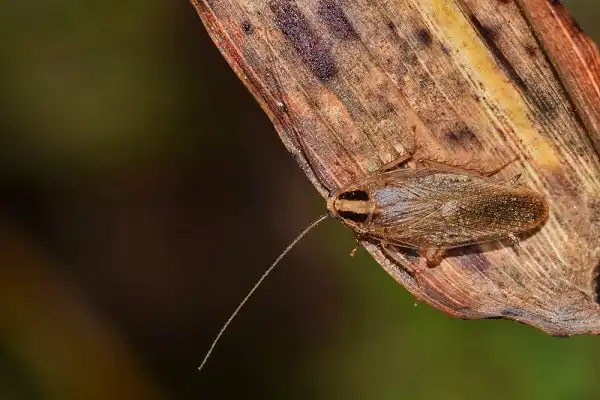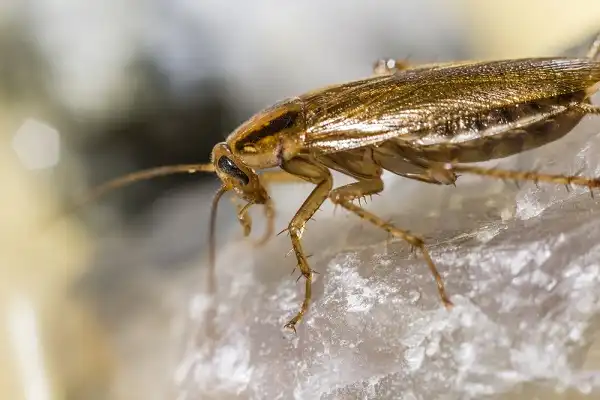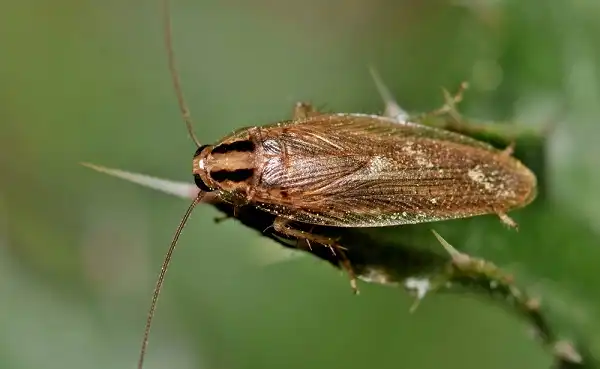Have you ever wondered what it would be like to come face-to-face with a German cockroach? This tiny, resilient, and tenacious creature can easily survive in the most harsh environments. These little bugs have been around since the age of dinosaurs and are considered one of the most difficult pests to get rid of. In this blog post, we will explore these intriguing insects, deciphering how they appear, their behavior, and ultimately why they are such a nuisance for humans.

German Cockroach Description
The German cockroach is a small, slim-bodied insect. It has two parallel, light brown stripes running down its back and dark brown mottling on its wings. Its head is generally darker than the rest of its body and it has long antennae that are around twice the length of its body. German cockroaches tend to have a more oval-shaped body than other species of cockroaches, making them appear rounder in comparison. German cockroaches reproduce extremely quickly. Their resilience makes them especially difficult to get rid of since they have developed a resistance against many common household pesticides over time.
German Cockroach Habitat
German cockroaches are highly adaptable and can be found in a variety of places, from residential homes to commercial kitchens and even outdoor gardens. They typically prefer warm, dark, and humid environments where they can find plenty of food and water sources. Indoors, they can often be spotted lurking near stoves, sinks, dishwashers, or other areas that provide them with sufficient moisture. They are also known to inhabit cracks and crevices along walls or near baseboards.
Outdoors, they will usually take shelter in woodpiles, trash cans, or any other area that provides them with warmth and protection from the elements. Given their versatility and ability to survive in almost any environment, it’s no surprise that German cockroaches are difficult pests to eliminate once an infestation has begun. The best way to prevent an infestation is by eliminating their sources of food and moisture as well as keeping the environment clean by vacuuming regularly and ensuring good hygiene practices such as properly storing food away from pests.
German Cockroach Diet
German cockroaches are omnivorous scavengers, meaning they will eat almost anything. Their diet primarily consists of a variety of food scraps, including crumbs, grease, and other organic matter. They will also feed on dead insects and even small mammals like mice or lizards if available. German cockroaches have been known to consume paper and cardboard as well as pet food and other non-edible materials. They get most of their hydration from the food they consume but can also drink water droplets found on moist surfaces such as sink basins or near leaky pipes.
These resilient insects can even survive for extended periods without access to food or water, relying instead on their stored fat reserves to sustain themselves in harsh environments. In addition to scavenging for food sources, German cockroaches have also been observed engaging in cannibalism when resources become scarce. This behavior is more likely to occur when living conditions are unfavorable or overcrowded which is why it’s so important to keep an eye out for signs of infestation before these pests become too numerous.

German Cockroach Size
The German cockroach is a small, slim-bodied insect that typically grows to about 1/2 – 5/8 of an inch in length. It’s smaller than other common species of cockroaches, such as the American or Oriental cockroach, which can reach up to 1.5 inches in length. Despite its diminutive size, the German cockroach is extremely resilient and can survive in harsh environments and without food or water for extended periods of time. Due to its slim body shape and coloring (light brown stripes on its back and dark brown mottling on its wings), the German cockroach can be difficult to spot until it breeds into large numbers.
This makes identifying an infestation early crucial for eliminating this pest before it takes hold. In summary, the German cockroach is a small but resilient insect that requires vigilant inspection for early detection of an infestation before they become too numerous and difficult to control. By understanding their habits and behaviors, it’s possible to take effective steps toward controlling these pests and preventing future invasions.
German Cockroach Lifespan
The average lifespan of a German cockroach is about 100 to 200 days, depending on the environmental conditions they inhabit. In optimal conditions, such as in an enclosed environment with plenty of food, water, and shelter, these pests can live up to a year. Females tend to live longer than males and can produce up to 400 offspring in their lifetime which usually takes place over the course of several weeks. German cockroaches are resilient insects that have developed a resistance against many common household pesticides over time. As such, it is important to take necessary steps to prevent an infestation by eliminating sources of food and moisture as well as regularly cleaning and vacuuming environmental areas.
This helps reduce their numbers and prevents them from breeding into large colonies. In the wild, the life expectancy of German cockroaches depends primarily on the availability of food and other resources, their ability to find shelter from predators or extreme weather conditions, and how long they can survive without sustenance. While they are able to live months without eating anything, prolonged periods without nutrition will weaken their immunity defenses and leave them more susceptible to disease-causing agents in their environment.
German Cockroach Behavior
German cockroaches are known to be extremely active and social insects, often congregating in large numbers when food is available. They can also be found in high-traffic areas such as kitchen counters, cabinets, and other food sources. They have been observed scavenging for food at night and using pheromones to communicate with each other about potential food sources or threats in the environment. Due to their small size, German cockroaches are very agile and can squeeze through small gaps or cracks which allows them easy access to inside homes and businesses. The behavior of German cockroaches changes based on environmental conditions – they typically remain hidden away during the day when there is light but become more active at night when it’s dark. This allows them to move around without detection and look for potential food sources while avoiding predators like birds or lizards.

German Cockroach Speed
German cockroaches are extremely fast insects, able to move up to 3 miles per hour. This speed enables them to search for food sources quickly and evade predators with ease. They can also climb smooth surfaces such as walls, countertops, and other objects, using their adhesive pads and claws to navigate tight spaces and crevices. The speed at which they run depends on the environmental conditions surrounding them; when temperatures are cooler, they tend to be slower in their movements whereas warmer temperatures allow them to move much faster.
When German cockroaches sense danger or perceive a threat from predators like birds or lizards, they quickly scurry away in a zigzag motion. This behavior enables them to confuse their predators and escape capture more easily. Additionally, they have also been observed engaging in group behaviors known as “swarming” where multiple cockroaches gather together to search for food sources or safety in numbers from potential threats.
German Cockroach Health Concerns
German cockroaches are known to be carriers of various diseases and pathogens, leading to health concerns for humans. They can spread bacteria, viruses, and parasites which can cause food poisoning, the flu, salmonella, and other illnesses. Furthermore, they are also capable of transporting allergens such as dust mites as well as triggering asthmatic symptoms in those with respiratory sensitivities. In addition to the direct transmission of harmful agents through contact with German cockroaches, their droppings and cast-off skins can also become airborne by vacuuming or sweeping which further increases the risk of exposure.
German Cockroach Hunting
German cockroaches are adept hunters, relying on their keen sense of smell to locate potential food sources in the dark. They have been observed entering homes through small cracks and crevices or sneaking inside through open doors and windows in search of food, water, and shelter. These pests have even been known to feed on things like glue, soap, leather, and paper products when other sources become scarce. When it comes to hunting, German cockroaches rely heavily on their antennae which they use to detect vibrations associated with movement as well as odors from potential food sources. Their excellent night vision also plays an important role in their hunting behavior as they are able to find prey over long distances by detecting heat signatures with their lateral eyes or ocelli located near their antennae.

Conclusion
In conclusion, German cockroaches are fast-moving pests that rely on their agility and keen senses of smell to detect potential food sources. They are also known to be carriers of various diseases and pathogens which can cause health concerns for humans if left uncontrolled. Additionally, they possess a pair of palps that allow them to taste different substances as well as ocelli near the antennae which gives them night vision enabling them to locate prey over long distances. It is important to understand the behavior of these insects in order to take effective steps toward preventing future infestations as well as controlling current populations.
Frequently Asked Question

